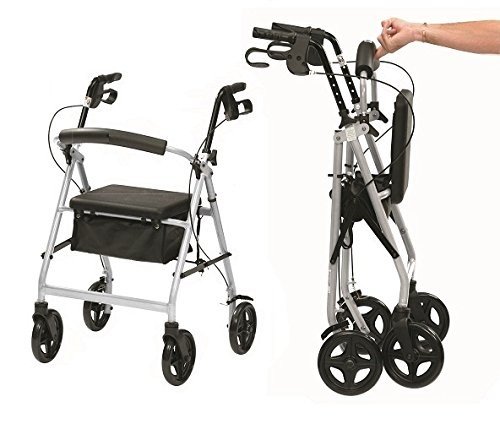walking-aids2491
walking-aids2491
Walker With Wheels Tools To Ease Your Daily Lifethe One Walker With Wheels Trick That Everyone Should Learn

Walker With Wheels: Revolutionizing Mobility for Enhanced Independence
Intro
For people experiencing mobility challenges, walkers have long been a relied on aid, offering stability and support. The introduction of walkers with wheels has transformed the landscape of assisted mobility, offering users higher self-reliance and flexibility. This post checks out the advantages, types, functions, and considerations surrounding walkers with wheels, gearing up readers with essential knowledge to make educated choices.
The Advantages of Walkers with Wheels
Increased Mobility
Walkers with wheels permit for smoother motion. The wheels supply improved maneuverability, enabling users to navigate various terrains, both inside and outdoors, with ease. This function lessens the exertion associated with walking, making it an appropriate choice for people recovering from surgical treatment, elderly clients, or those with persistent conditions.
Improved Stability
Lots of walkers with wheels come geared up with integrated brakes that supply users with a complacency. When fixed, users can engage the brakes, preventing the walker from rolling away accidentally. This function makes walkers with wheels much more secure, especially when navigating unequal surfaces or stepping aside to enable others to pass.
Practical Design
Advancements in design have caused walkers with wheels that deal with a broader variety of requirements. Some models come with additional functions, such as seats for resting, storage compartments for individual items, and ergonomic grips that reduce strain on the hands.
Kinds of Walkers with Wheels
When choosing a Walker With Wheels (Alm.Pragmatismo.Com.Br), consideration of private needs is crucial. The following prevail types of walkers with wheels:
| Type | Description | Perfect For |
|---|---|---|
| Two-Wheeled Walker | Features wheels just in the front, providing support from the back. | Those who require more support for balance. |
| Four-Wheeled Walker | Comes equipped with wheels on all 4 legs, permitting higher maneuverability. | Individuals seeking more self-reliance and dexterity. |
| Rollator Walker | A type of four-wheeled walker with a built-in seat and storage. | Users needing to take breaks and carry personal products. |
| Heavy-Duty Walker | Designed for people with greater weight capacities. | People requiring extra toughness and assistance. |
Secret Features to Consider
When exploring alternatives, potential users must consider the following features:
-
Weight Capacity: Each walker has a defined weight limit. Guarantee that the picked design supports the user’s weight comfortably.
-
Adjustable Height: Select a walker with an adjustable height function to make sure ideal posture and comfort for the user.
-
Brakes: Look for walkers with easy-to-use brakes that lock when the user stops.
-
Storage Options: Walkers with compartments or baskets use practical solutions for bring individual products.
-
Foldability: Many walkers fold for easy transportation and storage, a valuable function for users who often travel or visit places.
-
Ergonomic Grips: Comfortable grips reduce hand fatigue throughout use, boosting the walking experience.
Regularly Asked Questions (FAQs)
1. Are walkers with wheels suitable for outdoor use?
Yes, the majority of walkers with wheels are designed to manage numerous surfaces. However, it is necessary to pick a design with bigger wheels and proper tread for outdoor use to make sure stability and safety.
2. How do I choose which type of walker with wheels is best for me?
Consider your mobility needs, living environment, and personal preferences. Consulting with a healthcare specialist can offer personalized suggestions based upon your scenario.
3. Can I change the height of my walker?
The majority of modern walkers with wheels come with adjustable height settings. Constantly follow the producer’s instructions to make sure a safe and secure modification for your comfort.
4. How do I maintain my walker with wheels?
Routinely check the brakes, wheels, and overall structure for wear and tear. Tidy the walker with mild soap and water to maintain hygiene, especially if utilized outdoors.
5. Exist walkers with wheels developed particularly for users with specials needs?
Yes, particular designs cater to special needs, such as wider frames, strengthened handles, or additional encouraging features like grips or backrests. Highlighting specific requirements will assist in selecting the ideal product.
Walkers with wheels represent a significant improvement in mobility assistance, allowing users to preserve self-reliance and boost their quality of life. With various options offered, comprehending the different types, functions, and benefits of these walkers is crucial for individuals looking for one that fulfills their requirements. By purchasing the best walker, users can navigate their environments with confidence, ensuring a more active and satisfying way of life.
Last Thoughts
As we move towards a more inclusive world, the mobility aids readily available, like walkers with wheels, continue to adapt and progress. It is necessary for users, caretakers, and healthcare experts to stay informed about the latest designs and functions to ensure that mobility support is reliable, safe, and user-friendly.
In summary, walkers with wheels not only supply support; they empower individuals to recover their self-reliance, providing the freedom to engage with the world around them.




